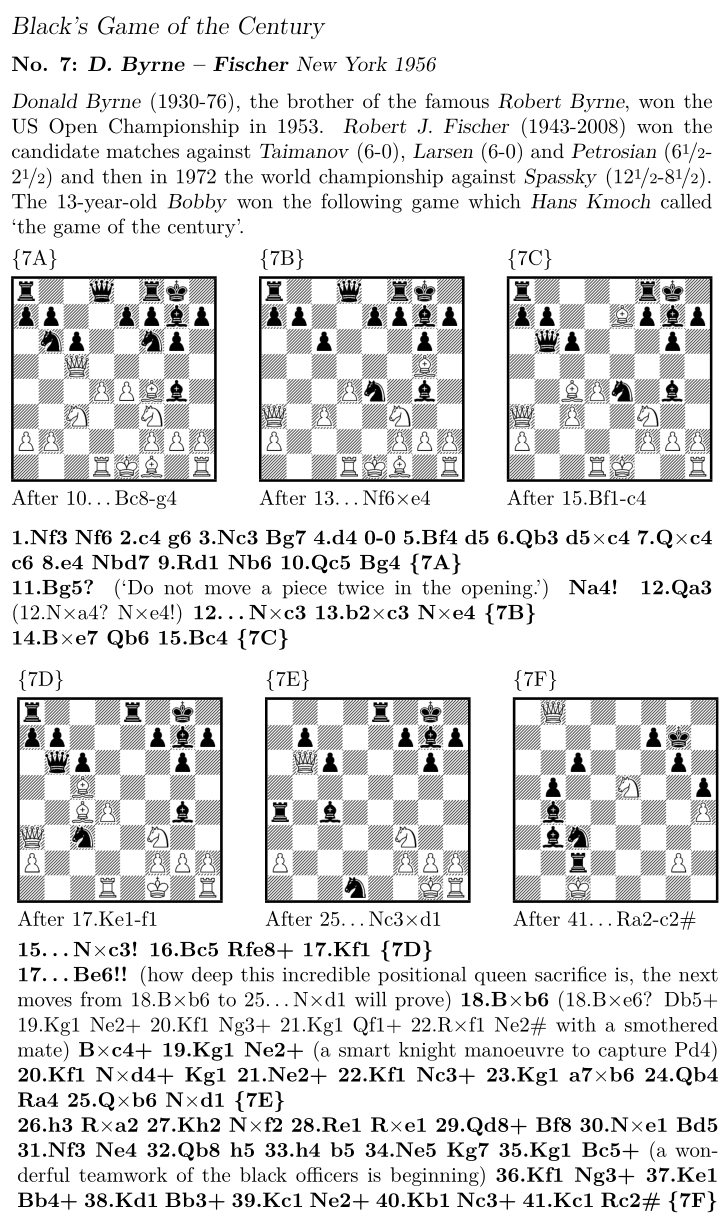 Anything but Average is a new chess book aimed at all chess lovers: players and problemists. We quote from the preface:
Anything but Average is a new chess book aimed at all chess lovers: players and problemists. We quote from the preface:
Over-the-board chess and chess composition complement each other wonderfully: battle and art. A game is a struggle between two people, a composition is the product of an individual. A chess game lives from mistakes, the chess problem dies from them. A game perfectly played by both sides often leads to a colourless draw, a perfect chess composition is an everlasting source of pleasure. Anticipation or plagiarism is irrelevant for the chess player, for the chess composer it means bad luck or violation.
Details: www.berlinthema.de (including a 24-page excerpt)
The second edition of this popular book is a delightful anthology of 400 chess games, combinations, endgame studies, problems, puzzles, riddles. Immortal games by Anderssen, Lasker, Fischer, Kasparov, Shirov, Carlsen and famous studies by Barbier-Saavedra, Troitzky, Réti, Pervakov and classical problems of all kinds as well as top compositions (selected as ‘Millennium problems’ by 38 experts in 2000) are presented and explained with additional diagrams, moreover compositions with asymmetry, castling, pawn promotion. The intention of the book is to entertain, rather than teach.

A general problem of such books – the replayability of the games and positions – is solved by the author in a laudable way.
First of all the diagram and the solution are always on the same page. You don't have to jump to a different section to find the moves.
Secondly the book provides many additional diagrams to help you play the moves in your mind. You can try it out: the image (click to enlarge) is a scan from the original. The game is the famous Byrne-Fischer. See if you can follow young Bobby's queen sac and the ensuing knight rampage directly on the page, with no replay function available on paper.
I think this is a very nice form of presentation, and I can just manage to follow almost everything in my head – understand the positions and the solutions. That is not the case for 90% or other chess publications – books and magazines – I own. Most of the content in them remains unread. Werner Keym's book I can read in a train or plane, or in bed before I switch off the lights.
Friend Werner has kindly given me permission to quote ad libitum from his book, which is in flawless English. He even suggested some positions for this article. The first we have shown you before, but not how it is presented in the book. Here's what that looks like. On our news page, of course, you can move the pieces on diagrams, but I have included the supplementary diagrams to show you how you can understand the study in your mind.
 No. 22: 1.Bh7? Kc3! 2.Kb5 Kd4 3.Kc6 Ke5 4.Kd7 (4.g6 Ke6 5.∼ Ke7 {22A} 1/2-1/2) 4...g6! 5.B×g6 Kf4 or 1.Bb3? Kc3 2.Kb5 Kd4 3.Kc6 Ke5 4.Bf7 g6! 4.∼ Kf4 5.∼ Kxg5 1/2-1/2 or 1.Kb4? K×c2 2.Kc4 Kd2 3.Kd4 Ke2 4.Ke4 Kf2 5.Kf4 Kg2 6.Kg4 g6! 1/2-1/2.
No. 22: 1.Bh7? Kc3! 2.Kb5 Kd4 3.Kc6 Ke5 4.Kd7 (4.g6 Ke6 5.∼ Ke7 {22A} 1/2-1/2) 4...g6! 5.B×g6 Kf4 or 1.Bb3? Kc3 2.Kb5 Kd4 3.Kc6 Ke5 4.Bf7 g6! 4.∼ Kf4 5.∼ Kxg5 1/2-1/2 or 1.Kb4? K×c2 2.Kc4 Kd2 3.Kd4 Ke2 4.Ke4 Kf2 5.Kf4 Kg2 6.Kg4 g6! 1/2-1/2.
The most improbable move wins: 1.Bb1!! K×b1 (1...Kc3 2.Kb5 Kd4 3.Kc6 Ke5 4.Kd7! g6 5.Ke7! Kf4 6.Kf6 1-0) 2.Kb3 Kc1 3.Kc3 Kd1 4.Kd3 Ke1 5.Ke3 Kf1 6.Kf3! {22B} 1-0, 6...Kg1 7.g6/Kg4 Kh2/Kg2 8.Kg4/g6. A singular bishop sacrifice.
In this case, example 22, there are two additional diagrams to help you follow the moves. They are marked {22A} and {22B} in the notation.

No. 25: 1.Rc7+ Rd7! (1...Kd6? 2.Qc5+; 1...Kf8? 2.Qf4+; 1...Ke6? 2.Qe3+ Kd5 3.Qd3+ 1-0) 2.Qc5+ (2.Qe3+? Kd8! 3.Qc5 Rd5+! 1/2-1/2) 2...Kd8 3.Kh6!! {25A} zugzwang 1-0, e.g. 3...Qxc7 4.Qf8# or 3...R×c7 4.Qf8+ Kd7 5.Q×b8 or 3...Ke8 4.Rc8+ or 3...Rh7+ 4.R×h7 Qh2+ 5.Kg6 Qg3+ 6.Qg5+. Other moves of wKg5 would draw (3.Kg4,Kh4,Kh5) or even lose (3.Kf5,Kf6,Kg6).
3.Kh6!! is one of the most splendid moves ever.
No. 40: 1.a7 f1Q 2.a8Q+ Qf8 3.Qd5+ Kh8 4.Qd4+! downstairs (4.Qd7? Qd6+ 0-1; 4.Qh1+? Bh4 5.Qa1+ Kg8 0-1) 4...Kg8 {40A} 5.Qc4+ Kh8 6.Qc3+ Kg8 7.Q×b3+ Kh8 8.Qc3+ Kg8 9.Qc4+ upstairs Kh8 10.Qd4+ Kg8 {40B} 11.Qd5+ Kh8 (8.Qd7? Qd6+! 1/2-1/2) 12.Qh1+! Bh4 13.Qa1+ Kg8 14.Qa2+ upstairs Kh8 15.Qb2+ Kg8 16.Qb3+ Kh8 17.Qc3+ Kg8 18.Qc4+ Kh8 19.Qd4+ Kg8 {40C} 20.Qd7 1-0. Queen staircase.

There is a JavaScript replayer below, where you replay all the lines, and even start an engine to assist in your analysis. But before we get to that, I want to show you one more remarkable problem from Werner Keym's book:
Here I am not giving the solution – you can try to work it out yourself. It is also not given in the replayer – but of course the engine will find the wonderfully baffling solution in a nano-second.
Werner Keym: Anything but Average – Chess Classics and Off-beat Problems. Second edition (cloth-bound) 2021. 25 € + postage.
Order per e-mail: Ralf.Kraetschmer@t-online.de
.jpeg)

















 Anything but Average is a new chess book aimed at all chess lovers: players and problemists. We quote from the preface:
Anything but Average is a new chess book aimed at all chess lovers: players and problemists. We quote from the preface:
 No. 22: 1.Bh7? Kc3! 2.Kb5 Kd4 3.Kc6 Ke5 4.Kd7 (4.g6 Ke6 5.∼ Ke7 {22A} 1/2-1/2) 4...g6! 5.B×g6 Kf4 or 1.Bb3? Kc3 2.Kb5 Kd4 3.Kc6 Ke5 4.Bf7 g6! 4.∼ Kf4 5.∼ Kxg5 1/2-1/2 or 1.Kb4? K×c2 2.Kc4 Kd2 3.Kd4 Ke2 4.Ke4 Kf2 5.Kf4 Kg2 6.Kg4 g6! 1/2-1/2.
No. 22: 1.Bh7? Kc3! 2.Kb5 Kd4 3.Kc6 Ke5 4.Kd7 (4.g6 Ke6 5.∼ Ke7 {22A} 1/2-1/2) 4...g6! 5.B×g6 Kf4 or 1.Bb3? Kc3 2.Kb5 Kd4 3.Kc6 Ke5 4.Bf7 g6! 4.∼ Kf4 5.∼ Kxg5 1/2-1/2 or 1.Kb4? K×c2 2.Kc4 Kd2 3.Kd4 Ke2 4.Ke4 Kf2 5.Kf4 Kg2 6.Kg4 g6! 1/2-1/2.






